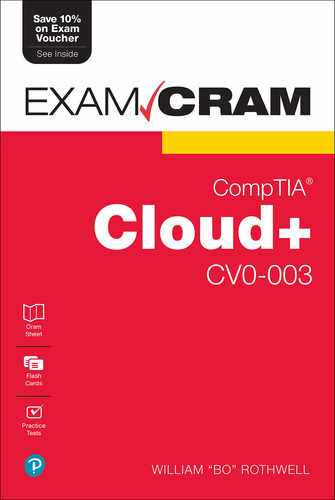CompTIA® Cloud+ CV0-003 Exam Cram is an all-inclusive study guide designed to help you pass the updated version of the CompTIA Cloud+ exam. Prepare for test day success with complete coverage of exam objectives and topics, plus hundreds of realistic practice questions. Extensive prep tools include quizzes and our essential last-minute review CramSheet. The powerful Pearson Test Prep practice software provides real-time assessment and feedback with two complete exams. Covers the critical information needed to score higher on your Cloud+ CV0-003 exam! Understand Cloud architecture and design Secure a network in a Cloud environment Apply data security and compliance controls and implement measures to meet security requirements Deploy Cloud networking solutions Perform Cloud migrations Optimize and maintain efficient operation of a Cloud environment Understand disaster recovery tasks Troubleshoot security, deployment, connectivity, and other performance issues Prepare for your exam with Pearson Test Prep Realistic practice questions and answers Comprehensive reporting and feedback Customized testing in study, practice exam, or flash card modes Complete coverage of Cloud+ CV0-003 exam objectives
Table of Contents
- Cover Page
- About This eBook
- Title Page
- Copyright Page
- Pearson’s Commitment to Diversity, Equity, and Inclusion
- Credits
- Contents at a Glance
- Contents
- About the Author
- Dedication
- Acknowledgments
- About the Technical Reviewer
- We Want to Hear from You!
- Reader Services
- Introduction
- Chapter 1. Different Types of Cloud Models
- Chapter 2. Capacity Planning
- Chapter 3. High Availability and Scaling in Cloud Environments
- Chapter 4. Solution Design in Support of the Business Requirements
- Chapter 5. Identity and Access Management
- Chapter 6. Secure a Network in a Cloud Environment
- Chapter 7. OS and Application Security Controls
- Policies
- User Permissions
- Antivirus/Antimalware/Endpoint Detection and Response (EDR)
- Host-Based IDS (HIDS)/Host-Based IPS (HIPS)
- Hardened Baselines
- File Integrity
- Log and Event Monitoring
- Configuration Management
- Builds
- Operating System (OS) Upgrades
- Encryption
- Mandatory Access Control
- Firewall Software
- What Next?
- Chapter 8. Data Security and Compliance Controls in Cloud Environments
- Chapter 9. Security Requirements
- Chapter 10. Incident Response Procedures
- Chapter 11. Integrate Components into a Cloud Solution
- Chapter 12. Storage in Cloud Environments
- Chapter 13. Cloud Networking Solutions
- Chapter 14. Compute Sizing for a Deployment
- Chapter 15. Cloud Migrations
- Chapter 16. Logging, Monitoring, and Alerting
- Chapter 17. Operation of a Cloud Environment
- Chapter 18. Optimize Cloud Environments
- Chapter 19. Automation and Orchestration Techniques
- Chapter 20. Backup and Restore Operations
- Chapter 21. Disaster Recovery Tasks
- Chapter 22. Troubleshooting Methodology
- Always Consider Corporate Policies, Procedures, and Impacts Before Implementing Changes
- 1. Identify the Problem
- 2. Establish a Theory of Probable Cause (Question the Obvious)
- 3. Test the Theory to Determine Cause
- 4. Establish a Plan of Action to Resolve the Problem and Implement the Solution
- 5. Verify Full System Functionality and, if Applicable, Implement Preventive Measures
- 6. Document the Findings, Actions, and Outcomes Throughout the Process
- What Next?
- Chapter 23. Troubleshoot Security Issues
- Chapter 24. Troubleshoot Deployment, Automation, and Orchestration Issues
- Connectivity Issues
- Performance Degradation
- Configurations
- Applications in Containers
- Misconfigured Templates
- Missing or Incorrect Tags
- Insufficient Capacity
- Licensing Issues
- Vendor-Related Issues
- Account Mismatches
- Change Management Failures
- Server Name Changes
- IP Address Changes
- Location Changes
- Version/Feature Mismatch
- Automation Tool Incompatibility
- Job Validation Issue
- Patching Failure
- What Next?
- Chapter 25. Troubleshoot Connectivity Issues and Common Performance Issues
- Glossary of Essential Terms and Components
- Index
- Where are the companion content files? - Register
- Code Snippets
